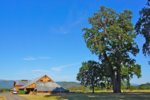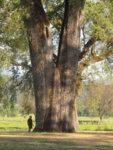I looked up the Valley Oak in the The Audubon Society Field Guide to North American Trees: Western Edition... looks like an awesome species! The lobes on the oaks are really deep and defined, and I like the shape of the Acorns as well! Would these do well in zone 7b on the east coast?
No. It won't, it's hardy to USDA zone 7-9. It might squeak by in N.J., but unless you know what you're doing and have adequate overwintering facilities, it's not going to be very good.
Best oak by far to use in the east is Willow Oak (quercus phellos). Cold hardy, backbuds readily, can be found in good sizes at nurseries. Easily collectible in larger (over 5 inches diameter) sizes from the wild. Naturally shallow root mass. Small narrow leaves that reduce.
White Oak (Quercus alba) is not all that terrific for bonsai. It is a hard-to-manage forest giant that doesn't respond well to bonsai techniques. For instance leaf pruning-which can be used to reduce leaf size and increase ramification--can result in white oak responding with LARGER leaves to compensate. Also hard to collect because of typically huge tap roots.
If you want to get a handle on the best native species to use as bonsai, poke around on Zach Smith's
Bonsai South Web site...It can give you an idea of what species or relatives that work east of the Mississippi. Also, Californians have more than a few species of oaks to work with for bonsai. By and large those species won't work very well here in the cold wet east.









